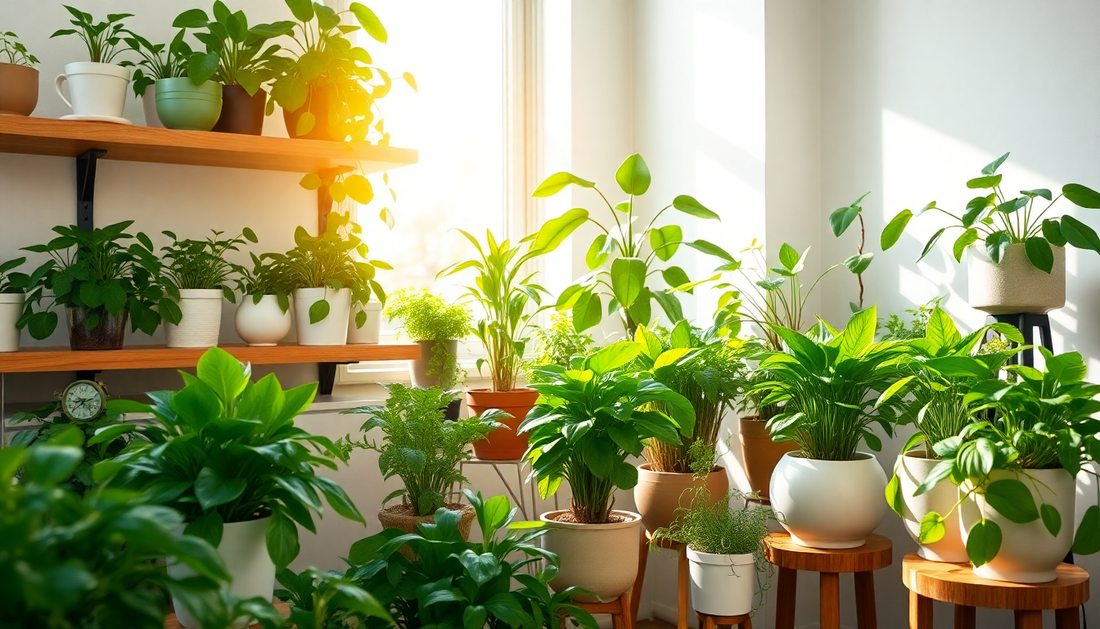
The Best Temperature for Disease-Free Indoor Plants
As the weather outside fluctuates, maintaining the ideal temperature for your indoor plants can be a delicate balancing act. Whether you're a seasoned green thumb or a budding plant parent, understanding the optimal temperature range for your houseplants is crucial for their health and longevity.
At Idyl, your one-stop shop for all your gardening needs in Bangalore, we're here to share our expertise on creating the perfect climate for your indoor oasis. From heat-loving succulents to cold-sensitive tropicals, we'll guide you through the dos and don'ts of temperature regulation to help your plants thrive.
The Importance of Temperature Control
Temperature plays a vital role in a plant's overall well-being. Just like humans, plants have specific temperature preferences that can make or break their growth and development. Exposing your indoor plants to temperatures outside their comfort zone can lead to a host of issues, including:
- Stunted growth
- Leaf discoloration or wilting
- Increased susceptibility to pests and diseases
- Reduced flowering or fruit production
By maintaining the ideal temperature range for your plants, you can create a thriving, disease-free environment that allows them to reach their full potential.
Understanding Plant Temperature Preferences
The optimal temperature for indoor plants can vary widely depending on the species. As a general rule, most houseplants prefer daytime temperatures between 65°F and 75°F (18°C and 24°C) and nighttime temperatures a few degrees cooler, around 55°F to 65°F (13°C to 18°C).
However, there are some exceptions to this rule. Certain plants, such as succulents and cacti, thrive in warmer conditions, while others, like ferns and African violets, prefer cooler temperatures. It's essential to research the specific needs of your plant collection to ensure you're providing the right environment.
Heat-Loving Plants
Some of the most popular heat-tolerant indoor plants include:
- Succulents (e.g., echeveria, jade plant, aloe vera)
- Cacti
- Citrus trees
- Bougainvillea
- Hibiscus
These plants can generally handle temperatures up to 85°F (29°C) during the day and 65°F (18°C) at night.
Cold-Sensitive Plants
On the other hand, some indoor plants are more sensitive to cooler temperatures and may struggle in conditions below 60°F (15°C). Examples of cold-sensitive houseplants include:
- Tropical plants (e.g., philodendrons, monstera, peace lilies)
- Orchids
- Begonias
- Nerve plants (Fittonia)
- Calathea
It's important to keep these plants away from drafty windows, air conditioning vents, and other sources of cold air to prevent damage.
Maintaining the Ideal Temperature
Achieving the perfect temperature for your indoor plants can be a delicate balancing act, especially in homes with fluctuating temperatures or limited climate control. Here are some tips to help you maintain the ideal conditions:
Monitor and Adjust Accordingly
Invest in a reliable indoor thermometer to regularly monitor the temperature in your plant's environment. Be prepared to make adjustments, such as moving plants to a warmer or cooler spot, using a space heater, or running a dehumidifier, to keep the temperature within the optimal range.
Utilize Natural Light and Ventilation
Strategically placing your plants near windows that receive ample sunlight can help regulate their temperature. Additionally, ensuring proper air circulation by opening windows or using fans can help prevent hot or cold spots.
Insulate and Protect
During colder months, consider using insulating materials, such as bubble wrap or horticultural fleece, to create a barrier around your plants and protect them from drafts. This can be especially helpful for cold-sensitive species.
Invest in Climate Control
For those with the means, investing in a dedicated grow room or greenhouse with precise temperature and humidity controls can provide the ultimate environment for your indoor plant collection. These climate-controlled spaces allow you to create the perfect microclimate for your plants, regardless of the outdoor conditions.
Troubleshooting Temperature-Related Issues
Despite your best efforts, your plants may still experience temperature-related problems. Here are some common issues and how to address them:
Wilting or Drooping Leaves
If your plant's leaves are wilting or drooping, it could be a sign of either too much heat or too much cold. Carefully observe your plant's other symptoms, such as leaf discoloration or texture, to determine the underlying cause and make the necessary adjustments.
Stunted Growth or Lack of Flowering
Prolonged exposure to temperatures outside a plant's preferred range can stunt its growth and inhibit flowering or fruit production. Adjust the temperature and monitor the plant's progress to see if it starts to recover.
Pests and Diseases
Extreme temperatures can weaken a plant's immune system, making it more susceptible to pests and diseases. Keep a close eye on your plants and address any issues promptly to prevent the spread of problems.
By understanding the temperature needs of your indoor plants and taking proactive steps to maintain the ideal conditions, you can create a thriving, disease-free environment that allows your greenery to flourish. At Idyl, we're here to support you on your journey to becoming a master of indoor plant care.
Whether you're looking to expand your plant collection or need expert advice on temperature regulation, our team of gardening enthusiasts is ready to assist you. Visit our online store or contact us today to explore our wide selection of plants, fertilizers, and gardening services tailored to your needs.







No comments